Broccoli has bloomed, what should I do? An unpretentious and healthy type of broccoli
I often hear negative comments about broccoli from gardeners. Basically, they complain that no matter how much they try to plant, it just goes into bloom. Because of this, they simply stop planting it, abandoning the most valuable vegetable.
Broccoli is really very healthy because it contains even more vitamins and microelements than cauliflower! It is rich in substances that prevent cancer and help remove cholesterol from the body.
It is useful to eat it in any form, especially fresh or lightly boiled. But many would be happy to eat it, but are forced to buy it in supermarkets because they either don’t garden at all or don’t know how to grow it.
So, it’s worth learning how to grow it if your health is important to you! And to do this you need to understand what is the secret of success? How and when to remove it correctly, so as not to miss the right moment, which many people miss and when they come to the garden they see a bush already in bloom?
Yes, Broccoli is very insidious in this matter, as soon as you hesitate, everything will bloom. But now we’ll figure out why this happens most often and how to avoid it.
The most important thing is the landing time! Yesterday, a friend of mine boasted to me that the broccoli had already sprouted... And this despite the fact that it is now incredibly hot in the apartments, and it will be possible to plant seedlings in a permanent place no earlier than mid-May!
What will most likely happen to her cabbages? Certainly! She will definitely only see broccoli in a blooming state...
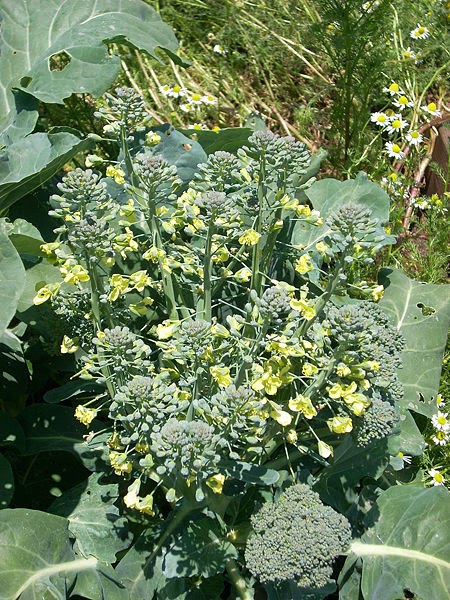
So, in all respects, broccoli is superior to its more popular relative - cauliflower. It is not afraid of spring frosts, it is practically not damaged, it is productive and has an increased repair ability, i.e. after harvesting the main head until frost, every 5-7 days it produces a harvest of numerous small heads the size of a chicken egg.
It is also less demanding on growing conditions. In addition, together with its heads, young shoots up to 15 cm long are also eaten, for which it is nicknamed asparagus cabbage. These seemingly dense shoots in ready meals so tasty and tender that they resemble soft butter.
There are two types of Broccoli in cultivation. The first one, more familiar to us, is called calabrese and has a hard head of dense inflorescences on a rather thick stem.
Second, asparagus or Italian broccoli, forms many stems with small heads. This cabbage has stems that taste like asparagus and are eaten.
Early varieties of Broccoli
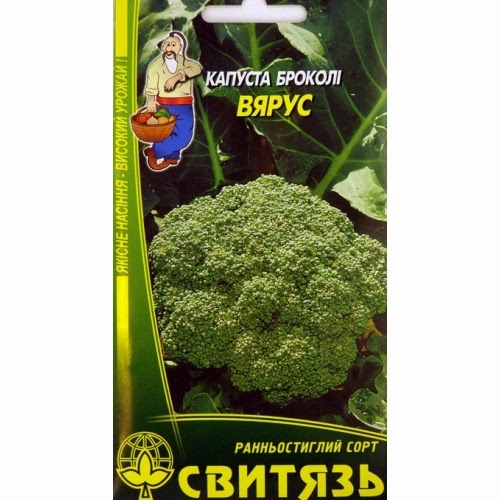
Vyarus– an early ripening variety with a horizontal rosette of leaves. The leaves are gray-green, vesicular. The head is small, green, finely tuberous, weighing up to 120 g, good taste. Forms secondary heads well.

Green Sprouting- early ripening variety. The rosette of leaves is medium-sized. The heads are compact, dense, weighing 0.3-0.4 kg.

Vitamin - early ripening variety. The growing season from germination to technical ripeness is 100-120 days. The rosette is 30-50 cm in diameter.
Emperor F1– an early ripening, very productive hybrid with a growing season of 75-80 days. The plant forms a powerful rosette of leaves. The heads are large, dome-shaped, with a smooth dark green surface.
Comanche– an early ripening variety, the heads are harvested 90 days after sowing the seeds. The heads are large, hard, green, and keep well on the vine. The variety is resistant to low and high temperatures.

Corvette F1– an early-ripening, magnificent hybrid, the heads ripen 60 days after planting the seedlings. The rosettes of leaves are powerful, resistant to adverse weather conditions, and tolerate dense planting. The heads are large, round, dense, grayish-green, have numerous lateral inflorescences, and are good for freezing.

Laser F1– a very early ripening hybrid, the heads ripen in 75 days. Both the main and lateral heads are dense and have a beautiful dark green color.
Samme King– an outstanding early ripening variety. The central head is large, very dense, convex, and the lateral ones are of medium size. The variety tolerates hot weather well, gives a good harvest both in early and late later growing.
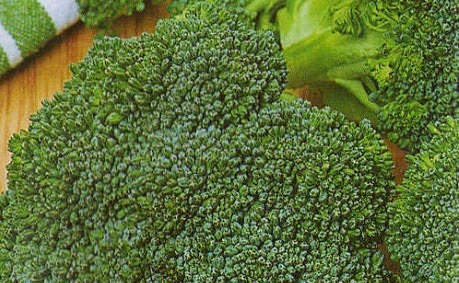
Tone– an early ripening variety with a growing season of 75-90 days and uniform ripening of the crop. Plants are capable of rapidly growing heads. The heads are dark green, medium density, weighing 0.15-0.25 kg, tall taste qualities. In cold or hot weather, the color of the heads may take on a brownish-brown tint.
Tribute F1– an early ripening hybrid with a growing season of 85 days. The hybrid is resistant to adverse external conditions growth. The heads are medium size, excellent taste.

Fiesta F1– an early ripening hybrid with a vertical rosette of leaves without side shoots. The head is dense, dark green, of excellent taste.
Mid-season varieties of Broccoli
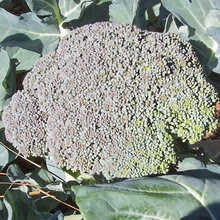
Atlantic – mid-season variety with a growing season of 125-135 days. The height of the stem reaches 50-60 cm. The plant forms a very powerful rosette of leaves and large dense heads. The weight of the central head is 0.2-0.3 kg, the maximum is 0.4 kg.
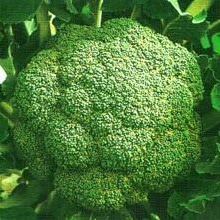
Arcadia F1– a mid-season, very productive hybrid, 110 days pass from sowing to ripening. The plant is powerful and tall. The head is large, dark green, weighing up to 0.4 kg. It is good for use in fresh and for recycling.
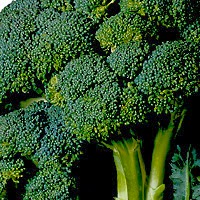
Genoa– mid-season variety, well suited for compact planting. The head is dome-shaped, with small flower buds, dark green, well preserved on the root.
Dwarf– a mid-season variety with a raised rosette of leaves and leaves that are strongly wavy along the edges. The head is gray-green, medium density, weighing up to 0.3 kg, excellent taste.

Greenbelt– mid-season variety, 105 days pass from sowing to harvest. Medium sized heads excellent quality, with very small flower buds.
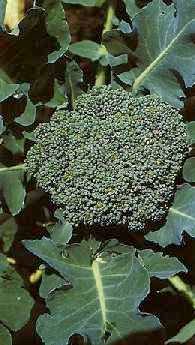
Greenia– a mid-season, very productive variety with a growing season of 125-140 days. The plant forms a large rosette of leaves up to 60 cm high. The heads are dense, weighing 0.2-0.3 kg.

Macho F1- mid-early (78-82 days from germination to technical ripeness) amicably ripening hybrid. Recommended for freezing and further use in home cooking.
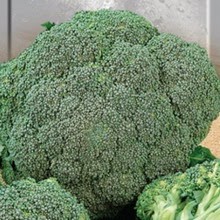
Calabrese– mid-season variety with a period from germination to ripening of 90 days. It is distinguished by friendly harvest ripening. The heads are medium dense, dark green. The mass of the main head is up to 0.4 kg, then the plant forms 6-7 lateral heads weighing up to 0.1 kg.
Konpakta– a mid-season productive variety, ripens 100 days after sowing. The plants are very compact and suitable for dense planting. The head is dome-shaped, large, with very small flower buds, dark green, well preserved on the root.
Monton F1– mid-season hybrid with a raised rosette of leaves. The head is large, weighing up to 0.8 kg, gray-green, medium density, excellent taste.
Senshi– a mid-season tall variety, 110 days pass from sowing to harvesting. The head is large, dome-shaped, hard, with small flower buds, dark green, and can be stored for a long time after picking.
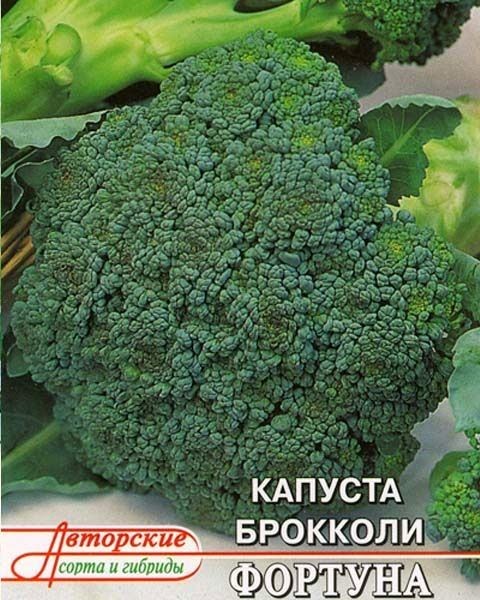
Fortune– mid-season variety with a raised rosette of leaves. The head is gray-green, medium density, weighing up to 0.15 kg, good taste.

Caesar– mid-season variety. Forms large, very dense, green heads with a purple tint. The density of the heads resembles cauliflower.
Late varieties of Broccoli

Lucky F1- late-ripening hybrid. The head is large, weighing 0.3-0.5 kg, very dense, with a delicate structure. The delivery period for products is very long.
Marathon F1– a late-ripening hybrid with a raised rosette of leaves. The head is large, weighing up to 0.7 kg, green, dense, with a delicate texture, excellent taste.
Good predecessors of Broccoli
Bad predecessors of Broccoli
Preparing Broccoli seeds for planting
Broccoli care
Broccoli loves moist, non-acidic soil, so these conditions can be maintained. It is advisable to plant broccoli in mixed plantings; good neighbors are peas, dill, cucumbers, carrots, chard, beets, celery, spinach, tomatoes, calendula and nasturtium. Do not plant cabbage next to watercress and onions.
When to cut broccoli?
To prevent the cabbage from going into color, monitor the weight of the head, look at the bag of seeds to see what is written there. If the recommended weight of the head is 400 g, then do not wait for a huge fruit; it is better to cut it at a weight of 350 g, then it will definitely not outgrow and will not have time to bloom.
The head of broccoli should be cut off with a knife without touching the side leaves. It would be good to feed the plant lightly. And after some time, side shoots with heads of inflorescences will appear. They will be smaller, but you can cut the shoots and cook.
Why doesn't Broccoli tie its heads?
Broccoli does not form heads even if there is an error in sowing time. Main secret growing broccoli is that the heads are formed only at temperatures up to 18 o C.
Thus, it is better to sow late varieties in such a way that the setting occurs during a period with not very high temperatures.
As practice shows, in September, when the nights are cold, the development of the head is slower, but it turns out to be much larger.
Don't forget about another important biological feature of broccoli. The fact is that it is moisture-loving and interruptions in watering negatively affect the development of plants.
She needs especially a lot of water at the time when the rosette of leaves is formed and the head of cabbage is tied.
Sometimes the formation of the head is delayed by fertilizing too late or too much with fertilizers. If you get carried away with fertilizing, instead of a head of cabbage, you can get a huge bouquet of cabbage leaves.
During all this time, Broccoli needs to be fed only three times: the first time one and a half to two weeks after planting the seedlings, and two weeks after that - the second time. The third feeding is carried out during the formation of heads of cabbage. I use vermicompost solution as a top dressing. The rest of the time, the plant receives all its nutrition through, which can be powdered with ash.
To get dense heads of cabbage, you need to protect them from direct sunlight. This means that as soon as the head of cabbage begins to set, or rather, when it becomes the size of Big apple, you need to break the rosette leaves or tie them over the head of cabbage. In such a cocoon, the broccoli head will calmly grow and develop.
This, of course, does not have to be done if you plant cabbage in mixed plantings or green manure.
In principle, all the secrets. The main thing is to comply with all the conditions when growing seedlings. This is often not possible to do on the windowsill due to the hot air. Therefore, it is better not to rush, but to plant seedlings later, but in a greenhouse or greenhouse in April-May.
When is it better to plant broccoli - spring or fall?
This generally depends on the variety, region and time of planting. Broccoli grows best when temperatures range from 5 to 21? C. The plant needs low temperatures to ripen during the cold season, so planting is generally done in late summer and harvest in the fall. In spring, broccoli needs to be planted early enough to be harvested before warmer temperatures arrive. Temperature - 4? C and below can damage or completely destroy the plant.
How do I know when my broccoli is ready to harvest?
Broccoli should be harvested when the plant's individual flower buds are the size of a pinhead, dark green and unopened, and have a firm consistency. If yellow bracts begin to appear and broccoli flowers begin to open, then they have lost their quality. Broccoli inflorescences depend on the crop variety, growing season and amount of fertilizer. Most homegrown broccoli reaches a diameter of 8-15 cm.
Can you grow broccoli in containers?
Yes. To do this, you need to use a container with a volume of at least 18 liters and a diameter of at least 45 cm.
Yellow spots appear on the upper side of the leaves growing in broccoli, and a mossy growth has appeared on the lower part of the leaves. What does it mean?
This is one of the forms of fungal disease. Some varieties of broccoli are resistant to this disease. In order to eliminate problems, you can spray fungicides on the leaves. Spraying should begin as soon as symptoms appear and repeat as recommended on the fungicide package.
How to control pests on broccoli buds?
These are probably cabbage pests that can be eliminated using biological pesticides containing the bacteria - Bacillus Thuringiensis (Bt). The bacteria must be eaten by the pests and activated within them. Pests die slowly, that is, within 2-3 days they completely disappear from broccoli.
For some reason, the broccoli quickly began to turn into small yellow flowers soon after they were planted, and the inflorescences were small. What is the reason?
The culprit is hot weather. The plant quickly enters the seed ripening stage. Broccoli blooms quickly at temperatures above 26? C. Planting occurred very late if it was done in the spring, or very early if you planted cabbage in the summer. It is recommended to cut off broccoli buds before the flowers bloom, no matter how small they are.
What should you do if your broccoli buds are slightly discolored and covered in mucus?
Unfavorable natural conditions, such as heat, when the buds form, they become discolored. This phenomenon was observed in the example hybrid varieties. Planting at the right time and providing proper care will avoid this problem.
After cutting off the broccoli buds, the stem of the plant has a hole where water accumulates, causing them to rot after harvest. What can be done?
The holes in the stems can no longer be repaired. This phenomenon is caused by boron deficiency and can be corrected by adding boron to the soil the following year.
Is it normal that the secondary broccoli florets are smaller and probably need fertilizer?
The central inflorescence of broccoli buds is always the largest, with secondary inflorescences measuring about 40 mm. Fertilizing will help increase the size of the inflorescences, but only slightly. However, small inflorescences are located in the axils of the leaves, and in the total mass they are no less than in the central inflorescence.
Some of the plants don't have broccoli florets but look healthy. What's wrong?
If broccoli's growing point is damaged, the plant cannot produce flower heads. This may occur due to damage to the plants during transportation, planting, or by insects in the garden.
Bark and peat for mulching broccoli? What other types of mulch can be used?
Although peat is sometimes used to improve soil, it is not suitable for mulching and can draw moisture from the ground. Not every bark is used for mulching. If it is pine, then it is not suitable for these purposes. It is best to use old (several years old) sawdust, rotted manure, dry grass (weeds) without seeds.
I planted broccoli again in August. The leaves are very healthy and large, such that I added several of the lower leaves to salads. Now that the bud inflorescences are about to appear, will this cause some damage to the further development of the buds?
For the development of the plant, it is necessary to leave leaves that can feed the plant (photosynthesis) and contribute to its further development, the formation of inflorescences of buds, for which you grow broccoli.
Broccoli, or asparagus cabbage widespread in Europe and the USA. Its homeland is the shores of the Mediterranean. During the times of Ancient Rome, it was cultivated there under the name Pompeii cabbage.
At first glance, broccoli and cauliflower look very similar to each other. But broccoli is distinguished by its lower density and different colors of heads located on fleshy shoots 15-20 cm long, which appearance and tastes like asparagus. That's why it is also called asparagus cabbage.
However, this crop still does not arouse much interest among gardeners, despite its great value, unpretentiousness and our climatic conditions that are extremely favorable for its cultivation.
It’s a pity, because broccoli is superior to cauliflower in all respects. It is not afraid of spring frosts, it is practically not damaged by pests, it is productive and after harvesting the main head before the frost, it produces a harvest of numerous small heads every 5-7 days. It is also less demanding on growing conditions. In addition, growing broccoli is a profitable business: it costs 1.5-2 times more than cauliflower.
In my own way chemical composition Broccoli firmly occupies a leading place not only among cabbage varieties, but also among other vegetable plants.
Broccoli contains vitamin C from 60 to 150 mg%, i.e. almost twice as much as cauliflower, carotene 0.2-0.8 mg%. The total protein content in it reaches 4%. By presence of majority essential amino acids broccoli is not inferior beef meat, and in terms of lysine content - a chicken egg.
Broccoli protein contains effective anti-sclerotic substances methionine and choline, which prevent the accumulation of cholesterol in the body and prevent the development of atherosclerosis. And it contains 4 times less purine substances, harmful for gout and kidney stones, than in cauliflower.
It is thanks to these exclusively valuable qualities Abroad, it is widely used for the prevention of atherosclerosis, as well as in the treatment of radiation sickness. In the last 15-20 years in Russia, broccoli has been remembered in connection with the Chernobyl tragedy. As it turned out, it helps cleanse the body of radionuclides and heavy metals.
There is information in the specialized literature that it can be used as a prophylactic against malignant tumors. It is not for nothing that in recent years it has greatly replaced cauliflower in all the main growing areas in the United States.
Boil broccoli heads in salted water, roll in breadcrumbs and fried. It is very useful fresh in salads. It is also possible to preserve and marinate it.
Asparagus cabbage is good for its extraordinary taste, aroma, and tenderness. It tastes like green asparagus and superior to cauliflower. It is best consumed as a side dish. And its young leaves in nutritional value and content useful substances equated to spinach.
In the hands of a skillful housewife, broccoli produces a dish of unique taste, after trying which you will... next year plant asparagus cabbage in the most honorable bed.
Broccoli forms a powerful, fleshy stem up to 50-60 cm or more in height. It has large elongated leaves with wavy edges and a long petiole.
Its head is similar in structure to the head of cauliflower. This is a modified inflorescence, i.e. a bunch of underdeveloped and twisted flower buds, closed by sepals of various colors green, blue, purple or white. The weight of the head of asparagus cabbage is usually 0.15-0.35 kg, in some varieties it is much larger.
Asparagus cabbage is a cold-resistant plant. Its seeds begin to germinate already at a temperature of 3 ° C. Established seedlings can easily tolerate short return frosts down to -3...4 °C. In autumn, plants also tolerate frosts down to -7 ° C. But in summer, asparagus cabbage reacts negatively to air temperatures above 22 °C.
The formation of a large vegetative mass can only occur in good light conditions. It is an exceptionally moisture-loving crop, but is less demanding on soil conditions than cauliflower.
When purchasing broccoli seeds, read the label carefully. Its varieties differ greatly in the shape and color of the head, as well as in its density. U early ripening varieties the central head is small and loose, while in later ones a large and dense central head is formed.
Broccoli is much less demanding on soil conditions than cauliflower, but a high yield can only be obtained with careful selection of the site: you need a place protected from the cold wind, preferably on a slight southern slope. Optimal areas are with a deep arable layer, well supplied nutrients, medium loams and black soils are best. Broccoli does not tolerate acidic soils, but lime should be applied only under the predecessor or in the fall.
Broccoli is undemanding when it comes to predecessors, but it is better if it is any well-fertilized crops, except those from the cruciferous family. Where carrots, beets, legumes and potatoes grew last year, asparagus cabbage will be especially comfortable.
In the fall, fertilizers are added to the soil (1.5 tablespoons of superphosphate and 1 teaspoon of potassium sulfate) and dug deep. In the spring, the soil is harrowed, and on the eve of planting, the seedlings are dug to a depth of 10-12 cm, adding 0.5 buckets of humus and 1 tsp per 1 m2. ammonium nitrate. Then the area is carefully harrowed. On highly moist soils, make high beds or ridges.
GROWING BROCCOLI
Preparing the soil and seeds, as well as growing broccoli seedlings, is carried out in the same way as cauliflower.
When grown by seedlings, asparagus cabbage is planted in 3-4 periods, starting from the first days of May until the end of June.
Seedlings grown without picking are ready for transplanting after 43-46 days, with picking after 50-55 days. Seedlings should have 4¬5 fully formed leaves. They are selected from the nursery early in the morning after preliminary hardening to cold and bright sunlight.
To obtain early production, broccoli seedlings are planted under a film cover in a bed in two rows, with a distance of 50 cm between them, and 30-35 cm between plants in a row.
But few gardeners know that, unlike cauliflower, in our conditions, broccoli can be easily grown without seedlings, sowing seeds directly into the ground. The timing of sowing seeds is from early May to mid-June.
If the seeds are sown in the ground in early May, the heads will ripen in the second half of July. When sowing seeds at the end of May, the heads will ripen in early August. If you sow in early June, you will receive a harvest in mid-August. For getting autumn harvest, the seeds are sown in mid-June directly into the ground. In this case, the collection of products will begin in mid-September and will continue until severe autumn frosts.
Seeds are sown in furrows or nests, planting them to a depth of 1.5-2 cm. It is best to place the rows every 55 cm, the distance in the row between plants is 20-30 cm. They are sown in moist, well-leveled soil, preventing the formation of soil crusts. The first time the plants are thinned to a distance of 10-12 cm, and the second time after 30-40 cm. Do not forget to add lime to the planting holes to avoid cabbage clubroot.
Caring for broccoli is the same as caring for cauliflower and boils down to regular watering, fertilizing, loosening and weeding the soil. Broccoli is very moisture-loving, so it needs to be watered weekly at the rate of 12-15 liters of water per 1 m2. During the growing season, such abundant watering must be done 4-5 times, in no case allowing the soil to dry out. Refreshing watering such as sprinkling is very useful, especially in hot weather.
Remember two important advice! First, even the shortest drying of the soil when growing asparagus cabbage cannot subsequently be compensated for by any heavy watering. And secondly, when extreme heat sets in, it is necessary to harvest the crop as early as possible, because broccoli buds quickly bloom in such heat, and it loses its commercial qualities.
After watering, as soon as the soil dries out a little, it must be loosened immediately, because asparagus cabbage does not tolerate soil crust. But it is necessary to loosen not deeply and carefully, since the root system is located at a shallow depth. During the growing season, soil loosening should be carried out 2-3 times.
Broccoli produces tall shoots that can fall over when exposed to rain or strong winds. Therefore, during the growing season, plants must be hilled twice to a height of 15 cm. In addition, this will also cause the growth of adventitious roots and increase plant nutrition.
During the season, broccoli should be fed twice, the first time this is done 2 weeks after planting. To prepare a solution, add 0.5 liters of mullein and 1.5 tbsp to 10 liters of water. l. nitrophoska, consuming 5 liters per 1 m2. The second feeding is done 2 weeks after the first with a solution of mineral fertilizers (per 10 liters of water - 1 tsp ammonium nitrate, 1 tbsp each of superphosphate and potassium sulfate).
Asparagus cabbage is extremely responsive to fertilizing with boron fertilizers (2 g per 10 liters of water).
Under favorable conditions, broccoli forms ripe heads 30-35 days after planting the seedlings, under unfavorable conditions - after 45-50 days. At this time, caring for it is exactly the same as for cauliflower, but, unlike cauliflower, its heads do not require shading.
CLEANING BROCCOLI
Harvesting is carried out in several stages. With good care, on the 75th-110th day after sowing (depending on the variety), large heads weighing up to 0.4 kg and with a diameter of up to 20 cm are formed. You should not chase very large heads; they must be cut off in a timely manner, until the buds are of which they are composed are small and tightly closed. The period of such readiness for harvesting is very short. Within 2¬3 days, the buds bloom and the plants bloom. In this case, the heads completely lose their marketability. It is especially important to monitor this in hot weather.
It is better to cut the heads early in the morning when there is dew or late in the evening. In this case, they will not wither longer. The heads are cut off along with a part of the fleshy stem 15-20 cm long, which is also used for food. In this case, it is necessary to make an oblique cut with a sharp knife so that rain or irrigation water does not get into the stem and rot does not develop there.
Delays in harvesting not only worsen the quality of the product, but also delay the development of lateral heads, which greatly reduces the overall yield.
After cutting the head, lateral shoots begin to grow quickly on the central stem, on which, after the formation of 3-4 leaves, heads also form. And if you continue to care for the plants, then many new lateral heads will grow on them, which must be removed when they reach a diameter of 4-6 cm. In July, these lateral heads should be cut off after 6-7 days, in August after 5-6 days , and in September after 3¬4 days.
Like cauliflower, broccoli can be grown in basements or deep greenhouses with a pit. To do this, 1¬2 days before digging up the plants, water them abundantly. Plants with a well-developed rosette of leaves are selected for growing.
D. Chernyaeva
Newspaper "GARDENER" No. 19, 2010.
Watering, caring and feeding broccoli.
It is recommended to water broccoli every other day (in hot summers - up to twice a day) in the evening. For normal growth and development of plants, it is necessary to maintain a moist soil layer with a depth of 12-15 centimeters.
For it, you can use organic fertilizers with potassium humate or a solution of mineral fertilizers - 40 grams of superphosphate, 20 grams of ammonium nitrate and 10 grams of potassium sulfate per 10 liters of water.
The following fertilizing is carried out after cutting the central head to stimulate the growth of lateral shoots. To do this, dissolve 30 grams of potassium sulfate, 20 grams of superphosphate, 10 grams of ammonium nitrate in 10 liters of water).
In addition, broccoli responds well to watering with infusion of nettle or comfrey and adding wood ash to the soil at the rate of 1 cup per 1 square meter.
6 Secrets to a Good Broccoli Harvest
To ensure that broccoli heads set well, be sure to feed the plants with fertilizers containing boron. For this purpose, you can use ash with the addition of boric acid (⅓ tsp per 10 liters of water).
In extreme heat, broccoli heads disintegrate quickly. Therefore, plant this crop together with some other type of cabbage or with vegetables so that the leaves above the bed are always closed.
You need to harvest broccoli while the heads have not yet opened (sometimes they open completely during the night). Therefore, make sure that when collecting the inflorescences are the size of a pinhead and dark green in color.
Broccoli without a “head” Alina STEPANOVA, agronomist
The heads of cabbage never set. Why could this happen?
The main secret of growing broccoli is that the heads form only at temperatures up to 18 ° C. Thus, it is better to sow late varieties in such a way that the setting occurs during a period with not very high temperatures.
As practice shows, in September, when the nights are cold, the development of the head is slower, but it turns out to be much larger.
The fact is that it is moisture-loving and interruptions in watering negatively affect the development of plants. She needs especially a lot of water at the time when the rosette of leaves is formed and the head of cabbage is tied.
Sometimes the formation of the head is delayed by fertilizing too late or too much with fertilizers. If you get carried away with fertilizing, instead of a head of cabbage, you can get a huge bouquet of cabbage leaves.
During the growing season, three feedings are usually carried out.
The first - one and a half to two weeks after planting the seedlings (for 10 liters of water take 0.5 liters of liquid mullein and a tablespoon of complete mineral fertilizer),
And two weeks after that - the second one. The working solution for the second is prepared from 10 liters of water, 30 g of ammonium nitrate, 2 g of potassium chloride, 40 g of superphosphate and 2 g of boric acid.
The third feeding is carried out during the formation of heads of cabbage. To do this, dilute mullein with water (1:8) and add 30 g of ammonium nitrate and superphosphate, 20 g of calcium chloride to 10 liters of solution.
To get dense heads of cabbage, you need to protect them from direct sunlight. This means that as soon as the head of cabbage begins to set, or rather, when it becomes the size of a large apple, it is necessary to break the rosette leaves or tie them over the head of cabbage. In such a cocoon, the broccoli head will calmly grow and develop.
Failure to fulfill even one of the listed conditions of agricultural technology, much less several, leads to the fact that the cabbage heads do not set.
Growing early broccoli is close to the agricultural technology of cauliflower, but to obtain the main head, broccoli seedlings are planted somewhat denser than cauliflower - at a distance of 20-25 cm between plants. Broccoli can also be grown by sowing seeds in open ground.
Broccoli grows best when shaded or fruit trees from 12 to 16 hours, as well as when moistening the soil when watering to a depth of 40 cm.
After cutting the main head, side shoots of broccoli develop, which can be removed after 15-20 days. Shading the heads of this cabbage is not required.
There are two main types of broccoli: calabrese and kale. Calabrese has a hard head and a thick stem on which there are many inflorescences.
Asparagus a large number of stems with small heads. These stems taste like asparagus.
In addition, it contains easily digestible protein, therefore it is a dietary product. Its protein contains methionine and choline, which have an anti-sclerotic effect and slow down the aging process. That's why they call her "cabbage eternal youth». Broccoli is indispensable in the diet of older people.
Broccoli is not fermented, canned or frozen; it is consumed fresh.
